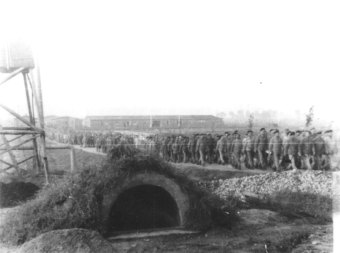Daily Routine

© Fritz Bauer Institute (APMO Collection / Auschwitz-Birkenau State Museum)
The days of the prisoners in the Buna/Monowitz concentration camp consisted of many hours of work, usually heavy labor, inadequate meals, and hence constant efforts to “organize” additional food. The inmates were wakened in summer at 5 and in winter at 6 in the morning by the sound of the gong from the central area used for roll-call, the Appellplatz. According to other information, reveille was as early as 4:30. In many cases, the Stubendienste (prisoners on barracks-room duty) undertook to speed up the process with bellows of “Out, out” and sometimes with beatings. Then the prisoners had half an hour to go to the few washrooms and have a few sips of imitation coffee for their “breakfast” before having to report for the roll call by number at 5:30, or in winter at 6:30. For roll call, the prisoners had to line up according to their blocks. It generally lasted about half an hour in the morning.
Then the work detachments were lined up. Any changes in the prisoners’ assignment to the detachments were decided the previous evening. As soon as the SS had formed a cordon to and around the construction site, the detachments had to march out. If it was foggy, departure was delayed until the SS no longer saw any danger of escape. The first prisoners to begin the march were those whose work area at the construction site was farthest away. The Kapos were required to state the headcount for their detachment; the detachments working inside the camp had to report their strength by 10 o’clock in the administrative office. Upon departure, the camp band played, and the prisoners had to march in time. On many mornings, prisoners who appeared to the SS at the camp gate to be no longer “fit for work” were selected, with I.G. employees playing a part in this decision
At the construction site, the prisoners frequently had to perform very hard labor outdoors and without the necessary protective clothing. At noon there was an hour-long lunch break, when the prisoners were given about 25 ounces of watery vegetable soup, the so-called Buna soup, which had scarcely any nutritional value. At the end of the midday break, there was another headcount to make sure that no one was missing. Then work was resumed until 6 in the evening, in winter until 5 P.M. or the onset of darkness.
The detachments had to return to camp in reverse order, with the Kapos once again required to report the number of people in their detachment at the camp gate. Then the prisoners had to line up according to block in the roll-call square. Those who had died or been injured were dragged to the roll call by their fellow prisoners, because the number had to agree with the tally made when they set out in the morning. The evening roll call lasted one hour or more. The prisoners were counted, and often some were also publicly punished or executed, for example, after attempted escapes. After roll call, work on upgrading the camp often still had to be done before the inmates were allowed to go back to their blocks. There they were given soup again and a little bread with margarine, intended to serve as the next day’s breakfast. Hunger and fear of theft, however, led many of the prisoners to eat the bread immediately. Then they had a bit of free time, which in many cases could be used to visit the infirmary, mend clothing, and trade shoes and other articles
At 9:30 P.M. in summer, 9 in winter, the sound of the gong announced that it was bedtime, and the light was turned off. After that time, prisoners could leave the blocks only to go to the latrines to use the toilet. Because of the extreme overcrowding of the blocks and the hygienic conditions, a restful night’s sleep was hardly a possibility for most inmates.
(MN; transl. KL)
















